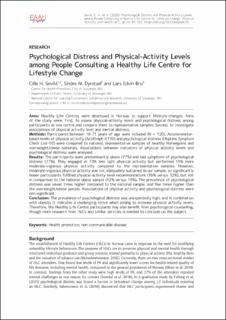| dc.contributor.author | Cille Hagland, Sevild | |
| dc.contributor.author | Dyrstad, Sindre Mikal | |
| dc.contributor.author | Bru, Lars Edvin | |
| dc.date.accessioned | 2023-01-20T11:30:01Z | |
| dc.date.available | 2023-01-20T11:30:01Z | |
| dc.date.created | 2020-12-15T10:00:04Z | |
| dc.date.issued | 2020 | |
| dc.identifier.citation | Sevild, C. H., Dyrstad, S. M., & Bru, L. E. (2020). Psychological distress and physical-activity levels among people consulting a Healthy Life Centre for lifestyle change. Physical Activity and Health, 4(1), 76-85. | en_US |
| dc.identifier.uri | https://hdl.handle.net/11250/3044924 | |
| dc.description.abstract | Aims: Healthy Life Centres were developed in Norway to support lifestyle-changes. Aims of the study were: First, to assess physical-activity levels and psychological distress among participants at one centre and compare them to representative samples. Second, to investigate associations of physical activity level and mental distress.
Methods: Participants between 18-71 years of age were included (N = 120). Accelerometer-based levels of physical activity (ActiGraph GT3X) and psychological distress (Hopkins Symptom Check List-10) were compared to national, representative samples of healthy Norwegians and overweight/obese nationals. Associations between indicators of physical activity levels and psychological distress were analysed.
Results: The participants were predominantly obese (77%) and had symptoms of psychological distress (77%). They engaged in 73% less light physical activity but performed 15% more moderate-vigorous physical activity compared to the representative samples. However, moderate-vigorous physical activity was not adequately sustained in our sample, so significantly fewer participants fulfilled physical-activity level recommendations (16% versus 32%), but not in comparison to the national obese sample (12% versus 19%). The prevalence of psychological distress was seven times higher compared to the national sample, and five times higher than the overweight/obese sample. Associations of physical activity and psychological distress were non-significant.
Conclusion: The prevalence of psychological distress was unexpectedly high, and in combination with obesity it indicates a challenging strive when aiming to increase physical activity levels. Therefore, the Healthy Life Centre participants may also benefit from psychological counselling, though more research from HLCs and similar services is needed to conclude on the subject. | en_US |
| dc.language.iso | eng | en_US |
| dc.publisher | Ubiquity Press | en_US |
| dc.rights | Navngivelse 4.0 Internasjonal | * |
| dc.rights.uri | http://creativecommons.org/licenses/by/4.0/deed.no | * |
| dc.title | Psychological Distress and Physical-Activity Levels among People Consulting a Healthy Life Centre for Lifestyle Change | en_US |
| dc.type | Peer reviewed | en_US |
| dc.type | Journal article | en_US |
| dc.description.version | publishedVersion | en_US |
| dc.rights.holder | the authors | en_US |
| dc.subject.nsi | VDP::Medisinske Fag: 700::Helsefag: 800 | en_US |
| dc.source.pagenumber | 76-85 | en_US |
| dc.source.volume | 4 | en_US |
| dc.source.journal | Physical Activity and Health (PAAH) | en_US |
| dc.source.issue | 1 | en_US |
| dc.identifier.doi | 10.5334/paah.55 | |
| dc.identifier.cristin | 1859844 | |
| cristin.ispublished | true | |
| cristin.fulltext | original | |
| cristin.qualitycode | 1 | |

